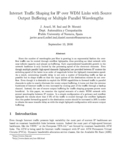Internet traffic shaping for IP over WDM links with source output buffering or multiple parallel wavelengths
Fecha
2001Versión
Acceso abierto / Sarbide irekia
Tipo
Artículo / Artikulua
Versión
Versión aceptada / Onetsi den bertsioa
Impacto
|
|
10.1023/A:1017267230889
Resumen
Since the number of wavelengths per fiber is growing in an exponential fashion the over-
flow traffic can be routed through overflow lightpaths, thus providing an ideal network with
near-infinite capacity and almost no-buffering. Such unprecedented bandwidth growth in the
network backbone is only limited by the processing speed of the electronic elements. Even
though multiple parallel high-speed ...
[++]
Since the number of wavelengths per fiber is growing in an exponential fashion the over-
flow traffic can be routed through overflow lightpaths, thus providing an ideal network with
near-infinite capacity and almost no-buffering. Such unprecedented bandwidth growth in the
network backbone is only limited by the processing speed of the electronic elements. Even
though multiple parallel high-speed channels (lightpaths) are provided between IP routers the
switching speed of the latter is an order of magnitude below the lightpath transmission speed.
As a result, minimizing transfer delay is not only a matter of forwarding traffic as fast as
possible but to shape traffic so that the input queues of the destination routers do not over-flow. Even though it is desirable to exploit the WDM capabilities to forward traffic in parallel channels in order to nearly eliminate the router output buffering, it turns out that the extreme
burstiness of Internet traffic is even increased by routing part of the traffic through a backup
channel. Instead, the use of source output buffering for traffic shaping purposes proves more
beneficial. In this paper, we examine the typical scenario of a static WDM network with
several wavelengths between IP routers. In a simple configuration of a primary and over
flow lightpath the results show that if 3% of the traffic is routed through the over
flow lightpath then the packet forwarding speed in the destination router should be increased in 20% in order
to obtain the same transfer delay as with the single lightpath configuration with source output
buffering. [--]
Materias
Internet traffic,
IP routers,
WPM,
Source output buffering,
Multiple parallel wavelength
Editor
Kluwer Academic Publishers
Publicado en
Optical Networks Magazine, January/February 2001, n. 1, vol. 2, pp. 61-68
Departamento
Universidad Pública de Navarra. Departamento de Automática y Computación /
Nafarroako Unibertsitate Publikoa. Automatika eta Konputazioa Saila





